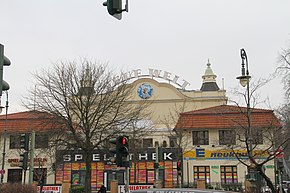New World (Berlin)

Die Neue Welt is a former beer palace and is located at the eastern end of Hasenheide Street in Berlin's Neukölln district . The outdoor area at the foot of the Rollberg has been used as a location for beer gardens since 1867 .
history
The New World was first mentioned in the Vossische Zeitung on April 23, 1880, when it was announced that the restaurateur Sternecker had taken over the establishment. Just two days later the first big concert was announced in the same newspaper. The music came from numerous military bands during those years . In addition to the other popular amusements, there was the so-called “Indian Hall” on the site, in front of it a large pond with fountains and cascades , a hippodrome , an open-air ring and a hall for the “ball champetrie” - the “rural ball”. A special attraction of the park was the electric train, which Werner von Siemens had already demonstrated at the trade fair in Moabit in 1879 .
Shortly after the turn of the century, the first large hall was completed, which offered space for almost 2000 people. This also made the New World a place for theater performances. It was also popular as a political meeting room. The SPD and the trade unions in particular held numerous meetings and rallies in the New World Hall. Many clubs and associations hosted Christmas parties, summer parties and industry meetings there.
In 1910, the New World was further expanded into an amusement park. Attractions were a water slide, a puppet theater, a photographer's studio and a wave run. A few years earlier, another event had been established with the Bockbierfest, which became a big hit with the public. In addition to enjoying drinks, competitions such as the award for the most beautiful woman's leg were responsible for the success.
During the First World War , the New World served as a military hospital . After that, the tradition of political gatherings was resumed. Not only the KPD and the trade unions were guests, but also right-wing groups such as the Stahlhelm in 1927. With the rise of the NSDAP , the New World increasingly became the site of National Socialist propaganda events, at which Joseph Goebbels also appeared. In the time of National Socialism loyalty to the state was the order of the day, so concerts with German swing bands such as Otto Kermbach became increasingly rare.
After a bomb attack in the spring of 1945, the New World could no longer be used for events. In 1946 the large hall was put back into operation after a renovation. It was now mainly used for film screenings and boxing matches. The Bock Beer Festival had lost none of its appeal.
After numerous changes of ownership and tenant, Karl-Heinz Kuhnert took over the direction in 1956. The manager of the stadium terraces at the Olympiastadion , later also the Deutschlandhalle , was to determine the fate of the New World until 1982. In addition to the Bock beer festival , catch events were an important pillar in the decades to come. In 1964 a bowling alley was built to attract additional visitors.
In the 1960s, beat , pop and rock found their way into the New World : Geno Washington and the Ram Jam Band, André Brasseur , Lee Curtis & the All-Stars, Sandie Shaw , Manfred Mann , Dave Dee, Dozy, Beaky, Mick & Tich , The Walker Brothers , not to forget the first appearances of Jimi Hendrix in Berlin. The organizer was often the Star Club Hamburg .
The Berlin left also rediscovered the New World as a meeting place. The SEW regularly organized the press festival of its newspaper Die Truth . An appearance by Rudi Dutschke in November 1966, when he gave his speech in front of the Bavarian-style decoration of the Bock beer festival, was particularly curious .
In the late 1970s, the small New World hall provided a stage for some internationally known artists such as Elvis Costello , Patti Smith , Graham Parker , Willy DeVille and the Dire Straits to perform. Rock musicians such as Bob Seger and Ted Nugent performed in the great hall . In the summer of 1979 the Festival of Fools took place in the New World . It is a Berlin offshoot of the event from Amsterdam . In 1980 Udo Lindenberg also found his way to Neukölln.
In the spring of 1982 the New World was closed. Now speculation about the property began. It took two years for a renovation to begin. The attempt to preserve the historical appearance failed. Together with a supermarket, a hall was created that housed a roller skate disco, Roller Skate Center Neue Welt , from 1985 to 1990 and has since been used for concerts (with up to 1,600 visitors) under the name Huxleys Neue Welt .
literature
- Lothar Uebel: The New World on the Hasenheide: Over a hundred years of pleasure and politics. Published by the Neukölln district office of Berlin, Berlin 1994.
Web links
Individual evidence
- ↑ Berlin Biographies (B) . In: Berlin monthly magazine ( Luisenstädtischer Bildungsverein ) . Issue 3, 1998, ISSN 0944-5560 , p. 94 ( luise-berlin.de - Becker, Adolf).
- ↑ Contribution by Karl-Heinz . Website Rock in Berlin, Berliner RockWiki, accessed on May 25, 2010
- ^ Kant-Kino; Reinhard Konzack, Fred Baumgart: Gigs in the Kant cinema: 5 year concerts, a photo book . Berlin 1980, p. 75
Coordinates: 52 ° 29 '10.7 " N , 13 ° 25' 17.4" E


